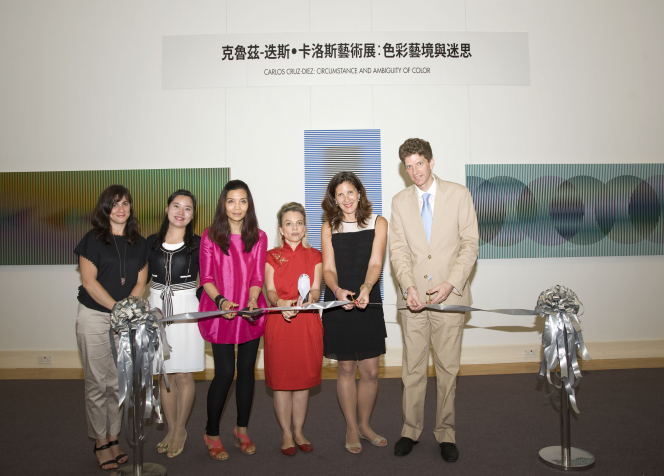Media
Expressing the power of colours through the environments of light “Carlos Cruz-Diez: Circumstance and Ambiguity of Colour”
23 May 2014
(From left to right) Ms Elena Calagna, Ms Xin Limei, Ms Zhang Lixin, Ms Anne Denis-Blanchardon, Ms Nicole Schindler and Dr Florian Knothe
An exhibition showcasing the works of contemporary master of colour, Venezuelan kinetic and op artist Carlos Cruz-Diez will be held at the University Museum and Art Gallery (UMAG) from May 24 (tomorrow) to August 17, 2014. This is the first time Carlos’ art pieces are on view in Hong Kong.
The exhibition, titled “Carlos Cruz-Diez: Circumstance and Ambiguity of Colour”, has been held in collaboration with the Cruz-Diez Foundation, Paris; China Youth Press, Beijing; ZBL & Associates and in association with Le French May, Hong Kong.
An opening ceremony for the exhibition was held today (May 23) at the University of Hong Kong (HKU). Officiating guests include, Consul for Cultural, Education and Science of the Consulate General of France in Hong Kong and Macau Ms Anne Denis-Blanchardon, Chief Executive Officer of Cuz-Diez Foundation Ms Nicole Schindler and Director of UMAG Dr Florian Knothe.
Celebrated for his attention to light and colour, Carlos’ paintings and light installations are based on his advanced theories on the perception of colour. He has been ranked among other masters of colours including Seurat (1859–1891), Cezanne (1839–1906), Albers (1888–1976), Frank-Stella (b. 1936).
Mr Cruz-Diez was born in Caracas, Venezuela, in 1923, and has lived and worked in Paris since 1960. His artistic roots reach back to the Movimiento Cinético (Kinetic Movement) of the 1950s and 1960s. As his thinking on the visual arts has evolved, his ideas have changed attitudes on how colour is perceived in art. Mr Cruz-Diez describes colour as an “autonomous reality, devoid of anecdotes, that evolves in real time and space with no need of form or support”. The presentation of his works embraces this theory and introduces the findings of eight research projects that reveal the myriad ways in which colour behaves: Couleur Additive (Additive Colour), Physichromie, Induction Chromatique (Chromatic Induction), Chromointerférence, Transchromie, Chromosaturation, Chromoscope, and Couleur dans l’espace (Colour in Space).
During the early modern era (17th–19th century) a lively academic discussion focused on the use and meaning of line versus colour. Whereas a group of artists adhered to the traditional preference of line and compositional elements, other artists argued that colour played a much more significant role than was previously admitted, and to them colour was equal to form. These fundamentally different approaches led to passionate disagreements in theoretical circles, and some of the ensuing arguments are now famous, such as the ones between Baroque painters Peter Paul Rubens (1577–1640) and Nicolas Poussin (1594–1665), or nineteenth-century artists Jean-Auguste Dominique Ingres (1780–1867) and Eugène Delacroix (1798–1863). As a consequence, French Impressionist art, which heavily relied on the power of colour, and of which Cruz-Diez is a distant disciple, did not appear in the West until the late nineteenth century when new scientific ideas — especially the invention of electricity and electromagnetism—transformed our concept of the world and, in the early twentieth century, showed us that the material universe we inhabit is basically the product of essentially non-material forces of energy.
Carlos Cruz-Diez’s works can be understood as a visual expression of a contemporary concept of reality. He is an heir to Impressionism and the Pointillists, and to all who have recognised colour as an essential compositional element of painting. His oeuvre is based entirely on chromatic phenomena; not, however, in a chemical-material sense but in terms of the spectra emitted by the pigments involved, like environments of light.
The French Minister of Culture awarded Carlos Cruz-Diez with an “Ordre des Arts et des Lettres – Commander” in order to acknowledge his prominent achievement and artistic status. His extraordinary oeuvre being shown in Hong Kong for the first time will not only manifests his theoretical concepts, but will also offer the Hong Kong public to experience the master artist’s diverse method of observing and distinguishing colours and guide us to perceive the ‘ambiguity of colour’.
Details of the exhibition “Carlos Cruz-Diez: Circumstance and Ambiguity of Colour”
Period: May 24, 2014 (Saturday) to August 17, 2014 (Sunday)
Opening Hours:
09:30 to 18:00 (Monday – Saturday);
13:00 – 18:00 (Sunday).
Closed on University and Public Holidays
For details, please visit http://www.hkumag.hku.hk/about_us.html
Venue: 1/F, T. T. Tsui Building, University Museum and Art Gallery, the University of Hong Kong
For location, please visit: http://www.hkumag.hku.hk/location.html
Tel: (852) 2241 5500 (General Enquiry)
Fees: Free Admission
Website: www.hkumag.hku.hk
For media enquiries, please contact:
Miss Elena Cheung (Communication Officer), tel: (852) 2241 5512, email: [email protected]
For details of the exhibition, please contact:
University Museum ad Art Gallery, the University of Hong Kong, tel: 2241 5500; email: [email protected]
Activities (details)
Bibliography of Carlos Cruz-Diez (details)
Induction Chromatique à Double Fréquence Maggy
100 x 300 cm
Paris, France
2011
(Photo Courtesy of the Cruz-Diez Foundation)
Carlos Cruz-Diez: Circumstance and Ambiguity of Colour
Henan Art Museum, Zhengzhou, China
2012
(Photo Courtesy of the Cruz-Diez Foundation)
Suprasensorial: Experiments in Light, Colour, and Space
The Geffen Contemporary at The Museum of Contemporary Art (MoCA)
Los Angeles, USA
2010
(Photo Courtesy of the Cruz-Diez Foundation)

